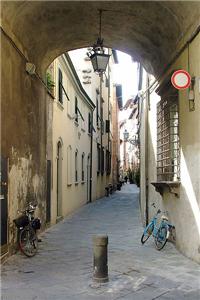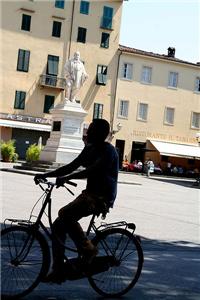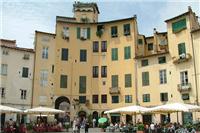The centre of the city of Lucca still shows many traces of its early history, dating back to the time it became a Roman colony in 180 A.D. The remains of the amphitheater and the forum located in the modern-day Piazza San Michele, as well as the first city walls to define a given area by enclosing the political (the Ducal Palace) and the religious (the church of San Michele, the baptistery and the church of Santa Reparata) centres.

As a result of its geographic location, the city was an important link for communications between the North and the South. Following the Longobard (or Lombard) period, which transformed Lucca into one of the most important capitals of the kingdom, it began to manufacture precious silks which marked the beginning of its economic, cultural and artistic development.
Lucca then went through a long period of instability. Different rulers followed one another in quick succession and there were frequent wars between Lucca and Pisa. In 1316, Castruccio Castracani led a popular revolt against Pisa and Florence, winning on all fronts and thus becoming the city's ruler. Under his leadership, a stable and healthy period ensued but upon his death, the city sunk into a long era of anarchy marked by extreme decadence.

The third ring of the city walls was built in the second half of the 15th century. A truce was signed with Florence which allowed Lucca to recover its former grandeur and stability and enjoy a new flourishing of the arts.
Many merchants became bankers and the subsequent shifting of capital from merchant activities to those of landowners transformed the economy. Construction of the last ring of the city walls (1544-1645), which remain intact to this day, was carried out to protect its new prosperity.
In 1700, the textile trade almost disappeared and the agricultural trade also faced a crisis. In spite of this, Lucca had become a model state. It was an independent republic for several centuries, peaceful and with very forward thinking and ideas.
During Napoleonic times, the city fell under the rule of Elisa Bonaparte, Napoleon's sister, who renovated its art and economy.

Today, Lucca remains a beautiful city with an enviable location: only a few kilometers from the sea of Versilia, less than an hour away from the Apennine Mountains, 60km (40 miles) away from Florence and 20km (13 miles) from Pisa.
The historical centre is entirely enclosed by the old city walls, the only ones in Italy which can still be accessed and that are very well-preserved. Its four kilometers (around three miles) of walls can be explored on foot or by bike (rentals possible on the spot) and provide a gorgeous panoramic view of the city and its surrounding areas. There are a great number of churches, which is why in fact the city is sometimes referred to as "the city of a hundred churches".

Lucca's main street is the Via Fillungo, or "long thread", which cuts through the middle of the city. This beautiful street, which still looks as it did in medieval times, is ideal for a perfect walk and stops can be made along the way to admire shoes in the shop windows, the colors of the different foods at the grocer's, the display windows of elegant shops or even ones whose awning and/or signs have been hand-painted.
The Piazza dell'Anfiteatro, the city's oldest and most striking square, can be found midway down the Via Fillungo and was built on top of the ruins of the ancient Roman amphitheater. The square leads onto Via Guinigi, where the tower of the same name can be found.
On the hills outside the city walls, a continual succession of small medieval villages and historical villas of considerable interest can be seen. Some of them may be visited by appointment.
During the month of September, there is a continual parade of events in Lucca one after another: cultural and religious events, festivals and street markets. The culmination of the month's festivities is the Santa Croce festival with many illuminations in honor of its patron saint. A long procession with crossbowmen and medieval masks is held and the day ends with fireworks. In April, as part of the festival of Santa Zita, the Piazza dell'Anfiteatro and all the shop windows are decorated with plants and flowers, lending a cheerful atmosphere to the city.